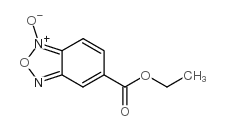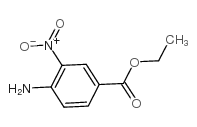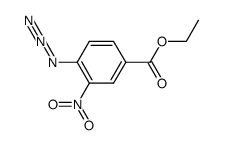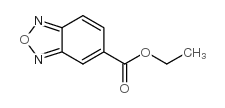ethyl benzofuroxan-5-carboxylate
Modify Date: 2024-04-02 19:11:11

ethyl benzofuroxan-5-carboxylate structure
|
Common Name | ethyl benzofuroxan-5-carboxylate | ||
|---|---|---|---|---|
| CAS Number | 17348-71-9 | Molecular Weight | 208.17100 | |
| Density | 1.45g/cm3 | Boiling Point | 335.7ºC at 760mmHg | |
| Molecular Formula | C9H8N2O4 | Melting Point | 66-67ºC | |
| MSDS | N/A | Flash Point | 156.8ºC | |
| Name | ethyl benzofuroxan-5-carboxylate |
|---|---|
| Synonym | More Synonyms |
| Density | 1.45g/cm3 |
|---|---|
| Boiling Point | 335.7ºC at 760mmHg |
| Melting Point | 66-67ºC |
| Molecular Formula | C9H8N2O4 |
| Molecular Weight | 208.17100 |
| Flash Point | 156.8ºC |
| Exact Mass | 208.04800 |
| PSA | 77.79000 |
| LogP | 1.43300 |
| Vapour Pressure | 0.000118mmHg at 25°C |
| Index of Refraction | 1.621 |
Synonym:Ethyl benzofuroxan-5-carboxylat Section 2 - COMPOSITION, INFORMATION ON INGREDIENTS
Risk Phrases: None Listed. Section 3 - HAZARDS IDENTIFICATION EMERGENCY OVERVIEW
Not available. Potential Health Effects Eye: May cause eye irritation. Skin: May cause skin irritation. May be harmful if absorbed through the skin. Ingestion: May cause irritation of the digestive tract. May be harmful if swallowed. Inhalation: May cause respiratory tract irritation. May be harmful if inhaled. Chronic: Not available. Section 4 - FIRST AID MEASURES Eyes: Flush eyes with plenty of water for at least 15 minutes, occasionally lifting the upper and lower eyelids. Get medical aid. Skin: Get medical aid. Flush skin with plenty of water for at least 15 minutes while removing contaminated clothing and shoes. Ingestion: Get medical aid. Wash mouth out with water. Inhalation: Remove from exposure and move to fresh air immediately. Notes to Physician: Treat symptomatically and supportively. Section 5 - FIRE FIGHTING MEASURES General Information: As in any fire, wear a self-contained breathing apparatus in pressure-demand, MSHA/NIOSH (approved or equivalent), and full protective gear. Extinguishing Media: Use water spray, dry chemical, carbon dioxide, or chemical foam. Section 6 - ACCIDENTAL RELEASE MEASURES General Information: Use proper personal protective equipment as indicated in Section 8. Spills/Leaks: Vacuum or sweep up material and place into a suitable disposal container. Section 7 - HANDLING and STORAGE Handling: Avoid breathing dust, vapor, mist, or gas. Avoid contact with skin and eyes. Storage: Store in a cool, dry place. Store in a tightly closed container. Section 8 - EXPOSURE CONTROLS, PERSONAL PROTECTION Engineering Controls: Use adequate ventilation to keep airborne concentrations low. Exposure Limits CAS# 17348-71-9: Personal Protective Equipment Eyes: Not available. Skin: Wear appropriate protective gloves to prevent skin exposure. Clothing: Wear appropriate protective clothing to prevent skin exposure. Respirators: Follow the OSHA respirator regulations found in 29 CFR 1910.134 or European Standard EN 149. Use a NIOSH/MSHA or European Standard EN 149 approved respirator if exposure limits are exceeded or if irritation or other symptoms are experienced. Section 9 - PHYSICAL AND CHEMICAL PROPERTIES Physical State: Solid Color: Not available. Odor: Not available. pH: Not available. Vapor Pressure: Not available. Viscosity: Not available. Boiling Point: Not available. Freezing/Melting Point: Not available. Autoignition Temperature: Not available. Flash Point: Not available. Explosion Limits, lower: Not available. Explosion Limits, upper: Not available. Decomposition Temperature: Solubility in water: Specific Gravity/Density: Molecular Formula: C9H8N2O4 Molecular Weight: 208 Section 10 - STABILITY AND REACTIVITY Chemical Stability: Not available. Conditions to Avoid: Incompatible materials. Incompatibilities with Other Materials: Strong oxidizing agents. Hazardous Decomposition Products: Hydrogen cyanide, nitrogen oxides, carbon monoxide, carbon dioxide. Hazardous Polymerization: Has not been reported Section 11 - TOXICOLOGICAL INFORMATION RTECS#: CAS# 17348-71-9 unlisted. LD50/LC50: Not available. Carcinogenicity: 5-(Ethoxycarbonyl)-2,1,3-benzoxadiazol-1-ium-1-olate - Not listed by ACGIH, IARC, or NTP. Section 12 - ECOLOGICAL INFORMATION Section 13 - DISPOSAL CONSIDERATIONS Dispose of in a manner consistent with federal, state, and local regulations. Section 14 - TRANSPORT INFORMATION IATA No information available. IMO No information available. RID/ADR No information available. Section 15 - REGULATORY INFORMATION European/International Regulations European Labeling in Accordance with EC Directives Hazard Symbols: Not available. Risk Phrases: Safety Phrases: S 24/25 Avoid contact with skin and eyes. WGK (Water Danger/Protection) CAS# 17348-71-9: No information available. Canada None of the chemicals in this product are listed on the DSL/NDSL list. CAS# 17348-71-9 is not listed on Canada's Ingredient Disclosure List. US FEDERAL TSCA CAS# 17348-71-9 is not listed on the TSCA inventory. It is for research and development use only. SECTION 16 - ADDITIONAL INFORMATION N/A |
| Hazard Codes | Xi: Irritant; |
|---|---|
| Safety Phrases | S24/25 |
| HS Code | 2934999090 |
|
~% 
ethyl benzofuro... CAS#:17348-71-9 |
| Literature: Journal of Medicinal Chemistry, , vol. 38, # 10 p. 1786 - 1792 |
|
~% 
ethyl benzofuro... CAS#:17348-71-9 |
| Literature: Journal of Medicinal Chemistry, , vol. 11, # 2 p. 305 - 311 |
| Precursor 2 | |
|---|---|
| DownStream 1 | |
| HS Code | 2934999090 |
|---|---|
| Summary | 2934999090. other heterocyclic compounds. VAT:17.0%. Tax rebate rate:13.0%. . MFN tariff:6.5%. General tariff:20.0% |
| 5-(ETHOXYCARBONYL)-2,1,3-BENZOXADIAZOL-1-IUM-1-OLATE |
| BUTTPARK 954-24 |
| benzofuroxan-5-carboxylic acid ethyl ester |
| MFCD00276595 |
| 5(6)-Ethoxycarbonyl-benzofuroxan |
| 1-oxy-benzo[1,2,5]oxadiazole-5-carboxylic acid ethyl ester |
| 5-Ethoxycarbonylbenzofuroxan |


 CAS#:36389-07-8
CAS#:36389-07-8